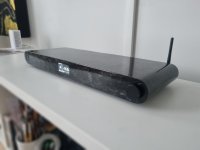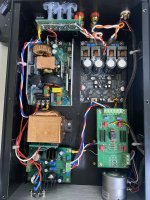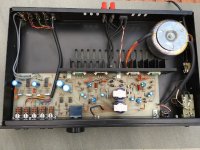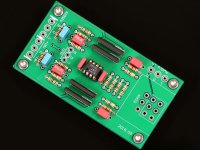@CharlieLaub
Looks like they are back in stock on the AliExpress store.
At least the model in orange, as of 22/08/23.

@3eaudio
Any short term terms for the higher power models? (Green)
Forgive me for my ignorance- what is the difference between the 23A and 29A models? Is that the max current rating ?
Or timeline for fully completed stereo or multichannel amps?
Looks like they are back in stock on the AliExpress store.
At least the model in orange, as of 22/08/23.
@3eaudio
Any short term terms for the higher power models? (Green)
Forgive me for my ignorance- what is the difference between the 23A and 29A models? Is that the max current rating ?
Or timeline for fully completed stereo or multichannel amps?
@tktran303
mono verison is under build and will available in 3 - 4 weeks,
please refer to this table for 23A and 29A models,it is inductor different.

mono verison is under build and will available in 3 - 4 weeks,
please refer to this table for 23A and 29A models,it is inductor different.
Update as of today;
I'm currently using the tpa3255 and 6l6 single tube amps.
Speaker: supravox 165gmf midrange + faitalpro hf108 compression driver+ rcf hf101 horn (cp at 1.3khz)

Change:
1. replace the buffer with sugden a25 preamp board to enjoy opamp rolling
2. shorten the dc cable to prevent any possible noise (no audible hum currently)
The attenuator works great with no channel balance at lowest volume.
I don't like to use digital volume in dac, which - I believe - would tend to affect sound at the cost of dynamic range.
And the sugden a25 board allows me to easily change various opamps, which is a lot of fun 🙂
Opamp rolling:
I have used opa828, opa627, opa1622, opa2604, dual ad797, etc
Of those, the opa627 in grandiose sound and opa828 in detailed yet transparent sound.
I believe the tpa3255 amp has bipolar input opamps on board, so the fet input opamp gives some tweak in sound, right?
I don't know but adding another option for a tone control would be a godsend gift, though 🙂

Recently, I have bought topping e70 dac and pa5 ii power amp.
I couldn't detect an audible difference between them or lack thereof. Therefore, I'll sell the topping pa5 ii soon.

I'm currently using the tpa3255 and 6l6 single tube amps.
Speaker: supravox 165gmf midrange + faitalpro hf108 compression driver+ rcf hf101 horn (cp at 1.3khz)
Change:
1. replace the buffer with sugden a25 preamp board to enjoy opamp rolling
2. shorten the dc cable to prevent any possible noise (no audible hum currently)
The attenuator works great with no channel balance at lowest volume.
I don't like to use digital volume in dac, which - I believe - would tend to affect sound at the cost of dynamic range.
And the sugden a25 board allows me to easily change various opamps, which is a lot of fun 🙂
Opamp rolling:
I have used opa828, opa627, opa1622, opa2604, dual ad797, etc
Of those, the opa627 in grandiose sound and opa828 in detailed yet transparent sound.
I believe the tpa3255 amp has bipolar input opamps on board, so the fet input opamp gives some tweak in sound, right?
I don't know but adding another option for a tone control would be a godsend gift, though 🙂
Recently, I have bought topping e70 dac and pa5 ii power amp.
I couldn't detect an audible difference between them or lack thereof. Therefore, I'll sell the topping pa5 ii soon.
Attachments
Last edited:
[ Change:
1. replace the buffer with sugden a25 preamp board to enjoy opamp rolling ]
https://usato.audiograffiti.com/annunci/amplificatori-integrati/216933/
https://es.aliexpress.com/item/32996057155.html
1. replace the buffer with sugden a25 preamp board to enjoy opamp rolling ]
https://usato.audiograffiti.com/annunci/amplificatori-integrati/216933/
https://es.aliexpress.com/item/32996057155.html
Attachments
Someone's posted an independent measurement confirming good performance here: https://www.audiosciencereview.com/...ft-pffb-fully-differential.47660/post-1707012
Does anyone know a mod / tweak of an existing amp or knows due to schematic how to transform a class D amplifier (like the TPAs) to current drive?
For those who do not know what current drive or CFA means - here more information on that:
https://www.current-drive.info/
Looking at the amplifier topolgies on this website ist there a possibility to use "basic current feedback" on a class D amp?
Any mod for an existing amplifier?

Figure b shows, correspondingly, the use of current-feedback* in its simplest form. Again, the non-inverting input terminal acts as the input, but now the feedback signal applied to the inverting terminal reflects the current flowing through the load (Io), instead of the load voltage.
For those who do not know what current drive or CFA means - here more information on that:
https://www.current-drive.info/
Looking at the amplifier topolgies on this website ist there a possibility to use "basic current feedback" on a class D amp?
Any mod for an existing amplifier?
Figure b shows, correspondingly, the use of current-feedback* in its simplest form. Again, the non-inverting input terminal acts as the input, but now the feedback signal applied to the inverting terminal reflects the current flowing through the load (Io), instead of the load voltage.
To explain this in simplistic terms, because you need access to the input to the actual "amplifying part" of the amplifier conversion is not possible without a bunch of of circuit surgery. Because this might mean trying to connect to a small or potentially hidden SMD pad for this sort of amplifier, I would not recommend it. Even worse is the fact that the schematics above to not apply to 99% of TPA32xx type amplifier boards because they are configured in bridge mode and the load is not ground referenced. Maybe try it with an LM3886 chip amp first.
Figure b shows, correspondingly, the use of current-feedback* in its simplest form. Again, the non-inverting input terminal acts as the input, but now the feedback signal applied to the inverting terminal reflects the current flowing through the load (Io), instead of the load voltage.
In the schematics above, you can see that for current feedback you need to connect the junction between the driver and current sense resistor to the inverting input of the amplifier. A "normal" voltage gain amplifier has other circuitry in the way as shown in (a) and you only have external access via the input at Ui.
IMO current drive can help reduce the 3rd order harmonic by 6-10dB in the midband, but it is not a panacea by any means and will introduce a bunch of other problems that will need to be solved (e.g. due to large changes in the frequency response).
Finally, this topic does not at all belong in this thread. If you wish to keep posting about current drive please use the forum's SEARCH feature and choose one of the many threads about current feedback to post in.
@3eaudio there are a good number of people who are doing builds with DSP. Have you considered a TAS3251 board for hobbyists? The Zoudio board seems to have a pretty active community here on DIYA so there's a market for it ong hobbyists.
@3eaudio Yes, JMF11 did his NeatAmp board, however it isn't a finished board (SMT soldering is required), there are no objective measurements of its performance and the software support is just from individual hobbyists because the design doesn't keep the XMOS controller from the TI EVM board.
It seems that if you design the TAS3251 board similar to their EVM and include the XMOS controller, then TI will share their XMOS firmware and you can use the PurePath software provided by TI:
https://e2e.ti.com/support/audio-gr.../tas3251-using-purepath-console-3-without-evm
However, looking at it more closely, it seems the XMOS controller may end up being too expensive to put on every board since it is a $266 board on its own.
It seems that if you design the TAS3251 board similar to their EVM and include the XMOS controller, then TI will share their XMOS firmware and you can use the PurePath software provided by TI:
https://e2e.ti.com/support/audio-gr.../tas3251-using-purepath-console-3-without-evm
However, looking at it more closely, it seems the XMOS controller may end up being too expensive to put on every board since it is a $266 board on its own.
Last edited:
I had the older ones of 3e TPA3255 then I got i love with MA12070 and the nice 3D sound so I was happy except the power was to little for my Purifi speakers.
But I sold the two older ones and bought the 260-2-29A just of curiosity.
I must say it sounds very good with pretty much same 3D sound without blind test.
Run it with LRS-350-48V, two way active with Topping Pa3s at HF.
Perfect combination!
But I sold the two older ones and bought the 260-2-29A just of curiosity.
I must say it sounds very good with pretty much same 3D sound without blind test.
Run it with LRS-350-48V, two way active with Topping Pa3s at HF.
Perfect combination!
Just bought a 260-2-29A too. I plan to measure and compare distortion to other low cost (Shui Yuan) TPA3255 boards I have.
- Home
- Vendor's Bazaar
- TPA3255, TPA3251 with Post Filter Feedback(PFFB)




